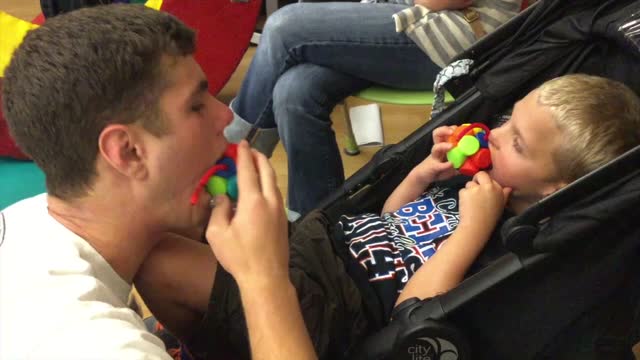Phase 2 Imitating
Children at the earliest developmental levels (birth to an emotional level of 2 years) will typically need the adult to utilize the techniques in Phases 1-3. Only when the child is developed emotionally to the level of 24 months will an adult use Phase 4 and then later Phase 5 with the learner.
Purpose of Phase 2 Imitation

The purposes of Phase 2 Imitation are:
- to increase the learner’s interest in activities nearby
- to increase the learner’s ability to initiate
- to increase the learner’s belief in him/herself
- to introduce activities and movements not yet performed by the learner
Adult’s Role
- In this phase the adult begins by imitating the actions of the learner on the objects, even if those actions are stereotypical.
- It is a good idea to have multiple numbers of an object.
- If the learner bangs on the object, so does the adult; playing alongside the learner exhibiting skills at the same emotional level.
- After a time, the adult can introduce a new action with the object while ensuring that the skill is within the developmental ability level of the learner.
General Guidance
- Observe if the learner will imitate the adult. If the learner does, this indicates the learner is beginning to pay attention to the activity of others in the environment. If the learner does not imitate the skill or exhibits negative behaviors, the adult should go back to imitating the action of the child again.
- Reflect on why the learner reacted to the new skill in such a way. Was the skill too difficult for the learner, too different than previous skills, presented in a way that reflected a demand or request, etc. The adult should make adjustments to his/her methodology the next time a new skill is introduced to the activity.
Phase 2 Imitation: Camron & Hollis
Description: Demonstration of imitation by brothers Camron and Hollis. Hollis uses a duplicate of the toy his brother is playing with to follow Camron’s lead and to imitate him. Notice that at some point Camron becomes aware of what Hollis is doing and responds.
Jace’s Joy (Living Deaf-Blind and Happy)
Jace is a boy who has a combined vision and hearing loss due to Goldenhar Syndrome. In this video we see his enjoyment of imitation games with his mother and friend.


